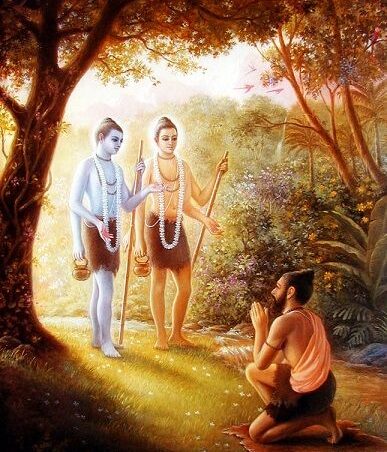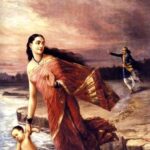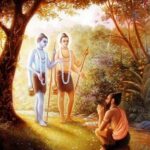Asuras doing penance to gain certain boons and blessings from Gods and then wreaking havoc upon humanity and many a time upon Gods themselves is a common scene in many Hindu texts. One such asura was Dambhodbhava, who lived during the Treta Yuga of Hindu cosmology(Treta means Three ie the age where the Bull of Dharma stood on 3 legs, also the age where 3 incarnations or avatars of Vishnu were born. The 3 avatars were Vamana, Parashurama and Rama respectively.) Dambhodbhava lived an ascetic life and did rigorous austerities for 1000yrs, chanting the name of the Sun God night and day. Finally, impressed by the devotion and penance of Dambhodbhava, Surya appears before him, and asks him for his wish, in reply Dambhodbhava requests Surya to make him immortal. Surya declines Dambhodbhava’s wish request saying “It is the Niti of Nature that one who is born will also die, no one can deny death as death is not an end but a continuation of life to the next level depending upon your karma in your mortal life.” Surya asks Dambhodbhava to wish for something else other than mortality. Dambhodbhava then comes up with a wily guileful request and asks Surya to grant him 1000 armours to be worn on his chest and that each of the armour can only be penetrated or destroyed by someone who has done penance by living an astute life for 1000yrs and also the one who penetrates or breaks an armour should immediately die. Hearing Dambhodbhava’s wishes Lord Surya becomes worried thinking about the future consequences, and since Dambhodbhava had performed such a rigorous penance just to gain the boon of immortality, which is denied, so his standby wish must be granted. Surya, as requested grants Dambhodbhava the boon of 1000 armours wearing on his chest.
A worried Lord Surya goes to Lord Vishnu’s abode seeking his help. Surya narrates Vishnu, the entire episode of Dambhodbhava attaining his boon of 1000 armours and how he is now fearful that Dambhodbhava may use his powers against Dharma. Hearing Surya, a smiling Lord Vishnu assures him to not be worried and that each time throughout time memorial whenever was there a rise in Adharma, that the shroud of fear and evil looked to envelop people’s mind and heart, that the light of hope seemed to douse, in such a chaos, every time Dharma has risen with a new face, to restore the lost sense of righteousness and truth in nature and shall again rise with a new face if the pot of evil and Adharma starts to overflow once again. Assuring Surya, that Dharma shall always have its way of defeating Adharma, and saving human society, requests Surya to not overthink and leave it to him if any such consequences happen in the future.
Soon after gaining the boon from Lord Surya, Dambhodbhava begins on his journey of Adharma and starts wreaking havoc on human society. Just seeing the sight of him, people would run to take shelter. Few brave kings and princes who showed courage standing against him were savagely killed and set as an example for the rest of the human society to not show courage challenging Dambhodbhava and simply comply with his demands. Due to his outer appearance of 1000 armours, people started calling him “Sahasrakavacha” ie one with 1000 armours. Around the same time, King Daksha (one of the Prajapati and one of Lord Brahma’s Manasputra- mind created son of Lord Brahma) got his daughter Murti married to another one of Lord Brahma’s Manasputra named Dharma.
After marriage, Murti lived with her husband in his hermitage and they both lived happily. But the nuisance of Dambhodbhava ever kept rising, day after day Dambhodbhava would wreak havoc in different human dwellings and kingdoms, commanding the people and their kings to surrender and accept him as their King or else die crushed under his feet. Murti too knew of the demon named Sahasrakavacha and his exploits and wanted to put an end to his ever-increasing peril & free the human society of Adharma, & so one day Murti decides to sit for meditation and pray to Lord Vishnu for help and guidance. For many days, without even eating or drinking Murti would stay in her meditation, praying and calling for Lord Vishnu, finally impressed with Murti’s prayers Lord Vishnu appears before her and asks Murti the reason for her calling. Murti explains to Lord Vishnu about the growing sufferings of people due to the non-stop menace and destruction done by the demon Sahasrakavacha and her wish to bring an end to this rising Adharma. An ever-smiling Lord Vishnu grants Murti the boon of being the reason for eliminating Sahasrakavacha. Lord Vishnu assures Murti that he will slay Sahasrakavacha, in his coming avatar, who shall be born as her son.
At the same time, there was another demon known by the name of “Hiranyakasypu”, who too was spreading horror among the human masses and eventually got killed by Lord Vishnu’s avatar of “Narasimha” when Hiranyakasypu tried to kill his own son “Prahlada” for being an ardent devotee of Lord Vishnu. (Hiranyakasypu considered Vishnu as his biggest enemy since his elder brother “Hiranyaksha” was killed by the “Varaha” avatar of Lord Vishnu.) After killing Hiranyakasypu and restoring Dharma, Lord Vishnu’s avatar of Narasimha took the human form of Nara and Narayana, where Narasimha’s head became Narayana & his body was reborn as Nara, the inseparable twins who took birth for the sole purpose of “the subjugation of 1000 armours Sahasrakavacha.”
Nara & Narayana grew up in their parents’ ashram at Badrinath within the forests. Both Nara & Narayana right from a young age became ardent devotees of Lord Shiva. Living in the ashram, Nara & Narayana learned all the Shastra’s (which included the Vedas, Vedangas, Samhitas, Aranyakas, Upanishads, Yoga Darshanas, Nyaya Darshanas, Mimamsa Darshanas, Sankhya Darshanas, Vyesheshika Darshanas, etc) & also learned the art of weaponry (Astra Shastra) and war policies (Yuddha Niti). They were also taught the powers of meditation and prayers and how to use them for one’s benefit & welfare or to transcend into a state of samadhi in the realization of the absolute & profound which is pure & white, without any seeds of anger, rage, desire or ego or any such emotions. With time, Nara & Narayana became so close and attached that without telling one could know the emotion felt by another or the thoughts one is having in his mind. Trusting one another without any doubt became the epitome of their brotherly bond. It’s been said that the tales of their brotherly bonding reached such extensive heights that one day Lord Shiva decides to put their prowess of bonding to test and so while the brothers were deeply meditating in the forest, Lord Shiva cast his most potent weapon, Paashupathastra in the direction of the meditating sages. If not the two inseparable brother sages, any other person or human in that place would have burnt to ashes but the combined powers of meditation of the two sages were so strong that even Shiva’s most potent weapon dropped neutralized. Seeing this Shiva stated that the two meditating brothers have reached the state of “Nirvikalpa Samadhi”, a state of no distinction between the knower, the things known and the act of knowing, a state of attainment of true enlightenment.
With time, the attacks of Sahasrakavacha reached Badrinath and soon the forest where Nara and Narayana stayed, along with their parents were also attacked. Seeing Sahasrakavacha wreck havoc, Narayana went and challenged Sahasrakavacha for a contest while Nara kept meditating. To see someone readily asking for a contest without any fear of death made Sahasrakavacha hesitant for the first time since gaining his boon. Both Sahasrakavacha and Narayana began to fight and soon after, Sahasrakavacha was stunned to see the strength of Narayana. He soon realized that the austerities of his brother Nara are giving strength to Narayana. Sahasrakavacha and Narayana fought for a 1000yrs and then Narayana broke one of Sahasrakavacha armour. Immediately after destroying Sahasrakavacha’s outermost armour Narayana fell dead and Sahasrakavacha breathed a sigh of relief, but the relief was not to be. As soon as Narayana fell dead, Nara woke up from his meditation and sprinted towards the dead body of his brother. Seeing the dead body, Nara quickly recited the Maha Mrityunjaya mantra into the ears of Narayana and brought him back to life. By performing astute austerities for 1000yrs Nara had gained the boon of knowing the Maha Mrityunjaya mantra from Lord Shiva- the mantra to revive the dead back to life. Seeing this Sahasrakavacha knew that both Nara and Narayana were born with the sole purpose of his destruction and that they are two bodies with one soul. After reviving Narayana, Nara took the place of his brother and continued fighting with Sahasrakavacha while Narayana sat meditating. Nara then fought Sahasrakavacha for the next 1000yrs and broke another armour and immediately fall dead. Then Narayana revived Nara, using the Maha Mrityunjaya mantra which he gained after pleasing Lord Shiva for his long astute penance meditating. This cycle of fighting and reviving went on until 999 armour’s of Sahasrakavacha was destroyed and an afraid Sahasrakavacha aka Dambhodbhava had to run away from the contest in fear of his life realizing that he could never defeat the two brothers since one gets his strength from the other’s penance and after falling dead is always revived by the other using the boon of Maha Mrityunjaya mantra. Running away from the two brothers Dambhodbhava took refuge at Lord Surya’s abode. When the brothers went to Lord Surya’s abode and requested him to surrender Dambhodbhava to them as they have to fulfil the cause of their mortal birth by slaying Dambhodbhava and restoring Dharma in the entire world, Surya resolutely declined their request and instead decided to shield his biggest devotee. Unable to get hold of Dambhodbhava and fulfil the purpose of their mortal life, Nara cursed Surya to be born as a mortal in the next life, which Lord Surya accepted just to save his devotee.
This entire episode marked the end of the Treta Yuga timeline. (also in many Hindu Scriptures, Lord Rama Jal Samadhi in River Sarayu marked the end of Treta Yuga.) Soon after, the third-best yuga in the cycle of time ie The Dwapara Yuga started, which saw a decline in spirituality and virtue and a rise in evil and vice. To fulfil the pending cause of their previous birth, Nara and Narayana were reborn as Arjun and Krishna. Whereas, Dambhodbhava was reborn as Karna with Lord Surya’s fraction within him as a result of Nara’s curse to Surya in the previous life. Also, Karna was born with natural armour, signifying the last of the 1000 armours of Sahasrakavacha. Since Karna was born as the incarnation of the demon Dambhodbhava, throughout life he had to pay for the bad Karma of his previous life and so right from birth to his death, Karna’s life was filled with many difficulties, sorrow and many unjust episodes, but Karna was also born with Lord Surya’s ansh within him which made him courageous, fearless, honest, dharmik, compassionate and charitable, which made him a hero for the general people. Even with such qualities and an undying spirit of righteousness, Karna had to be part with the Kauravas and befriended with Duryodhana, supporting his evils even though in his heart he always had a feeling of detestment for most of Duryodhana’s deeds, because of all the evils he had done in his previous life as Dambhodbhava and so paying his due for bad Karma in this life as Karna. Karn was also given the sobriquet of “Danveer” (Bountiful) for his genuine hearty generosity. The greatest example of Karna’s generosity was witnessed by people when Lord Indra went in disguise as an old weak brahmin at Karna’s alms-giving assembly and asked for his golden armour and earrings, even though Karna was conscious about the true identity of the old Brahmin and the reason for such a wily request, Karna sticking to his oath of not sending anyone empty-handed from his alms-giving assembly, using his dagger Karna cut open his natural armour off his chest and also his earrings and handed over to the old man aka Lord Indra. Lord Indra was aware of the fact that The Great Warrior Karna can never be defeated on the battlefield wearing his natural golden armour and so for the sake of his son Arjuna, and to ensure Pandavas victory at Kurukshetra, Indra decided to test and trick Karna by asking him for his greatest treasure and depriving him of it. In some Hindu texts, its mentioned that it was Lord Krishna’s shrewdness who sent Lord Indra to the assembly wearing a disguise and asked Karna for his golden armour and earrings. All this happened just days before the commencement of the Kurukshetra war. Karna died on the 17th day of the war and only after the war ended did the five Pandava brothers came to know of the true identity of Karna as their eldest brother, Kunti’s first child.





